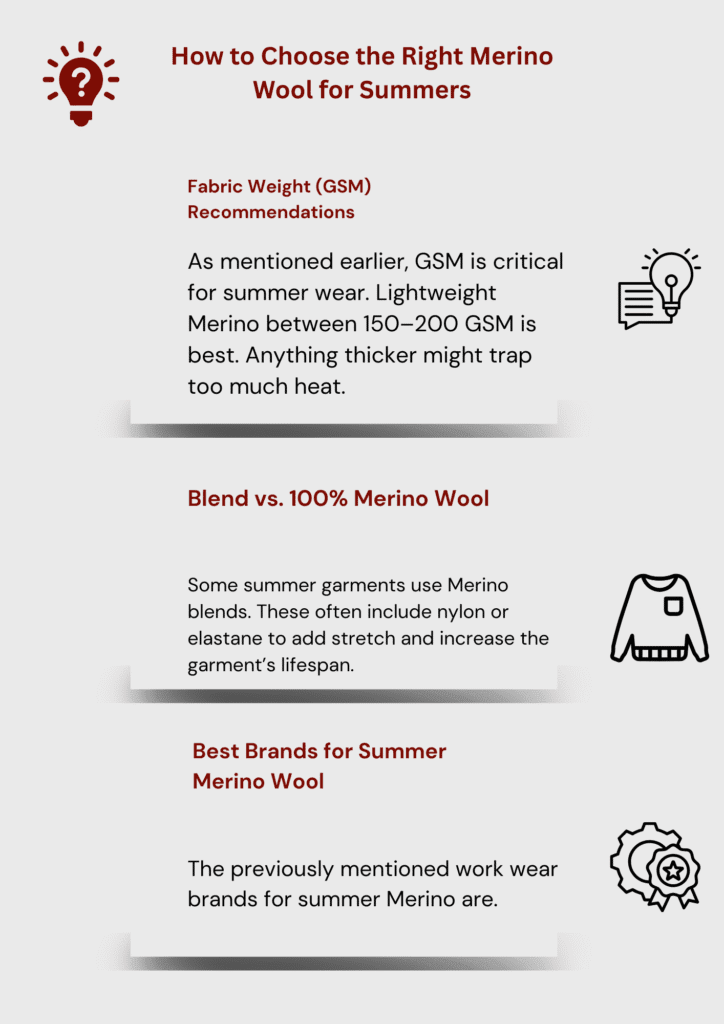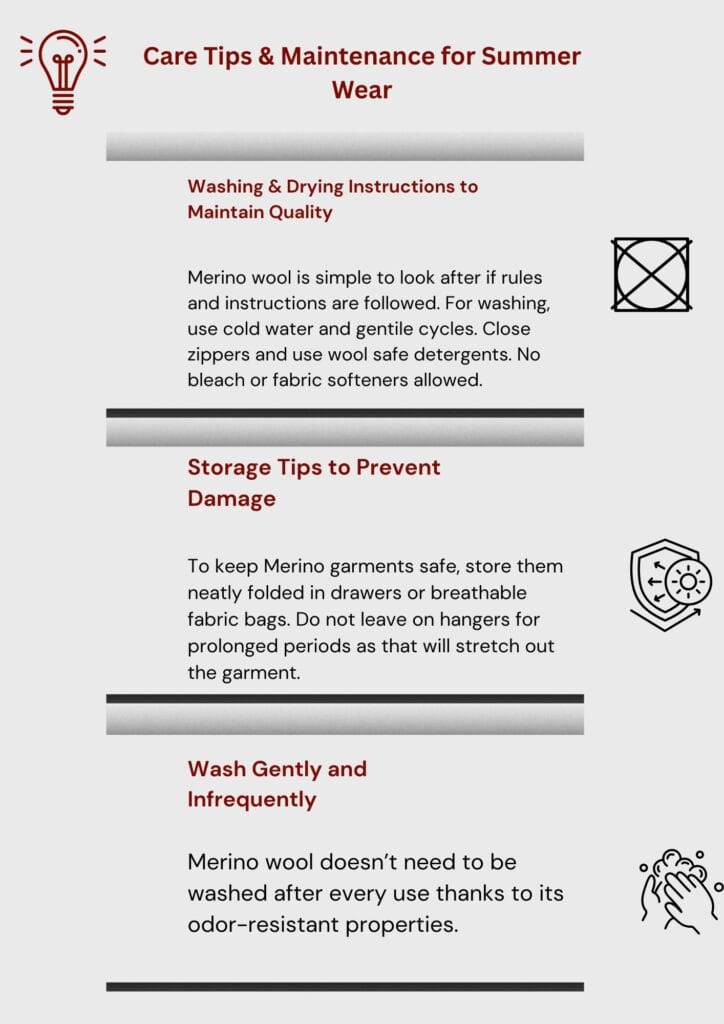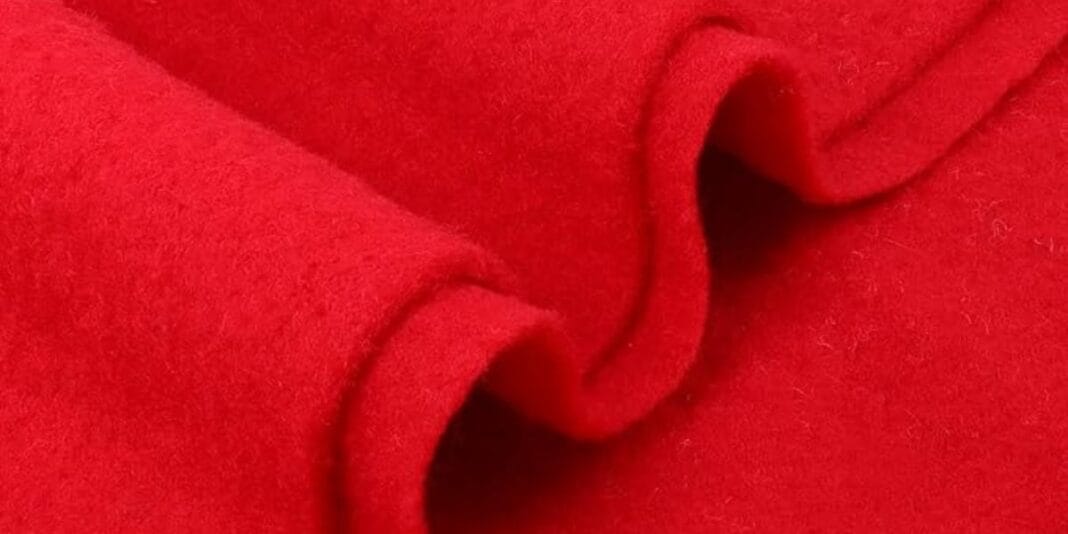Introduction
Short description of Merino wool
Merino wool is obtained from Merino sheep, which were originally bred in Spain but are now mainly located in Australia and New Zealand. It is a natural fibre that is easier to obtain than traditional sheep wool because it grows finer and softer. Unlike sheep wool, Merino wool is smooth and comfortable on the skin.Is Merino Wool Good for Summer
Merino wool’s prized insulating and moisture-regulating qualities make it a popular choice for clothing in both summer and winter Australia. It has become widely accepted for wearing during high endurance activities such as traveling, hiking and exercising. Now the major question arises, whether Merino wool is suitable for summer. Let’s find out the answer.
What makes it unique from other wool types
Compared to regular wool, Merino wool is significantly finer and softer. This also means that regular wool is above 30 microns, merino wool will only range from 17-21 microns. Merino’s unique structure helps provide a smoother feel and less itchiness. Its elastic, crimped design captures air which is useful in moderating body temperature.
Furthermore, Merino wool fibers can uptake to 30 percent of their weight to moisture and still feel dry. Unlike synthetic fabrics, Merino wool does not trap perspiration and odor. These differences set Merino wool apart as a revolutionary fabric for summer clothing.
Why Merino Wool is Good for Summer
Temperature Regulation – How it Keeps You Cool in Heat
Perhaps one of the best features of Merino wool is temperature control. As with its other functions, the natural fibers are very accommodating to the body. They assist with heat displacement in the summer, but rather help in keeping your skin cool.
The fibers themselves can retain or release air, depending on the outside environment. Therefore, you won’t experience any overheating even in hot regions. That’s the reason so many hikers and athletes embrace Merino wool for summer outings.
Moisture Wicking Merino Wool – Absorbing Sweat and Dries Fast
Merino wool has an upper hand in that it draws out moisture which can stay on your skin and brings it to the outer layer of the fabric. This is done through a process known as moisture wicking. Even during intensive exercises, it is possible to stay dry by using this fabric.
Furthermore, Merino wool’s quick-drying capabilities work excellently during humid showers, summer hikes, or workouts. Unlike cotton, Merino wool evaporates moisture much faster, and in those hot summer months, you are left feeling fresh. Merino is definitely summer friendly.
Effort and Time Saved
Compared to synthetic fabrics, Merino wool is more breathable as its structure allows airflow. Through Merino, moisture and heat can be carried away from your body which helps maintain ventilation.
During hot summers and high altitude trips, you will be thankful towards Merino for keeping your skin cool and dry. For any piece of clothing to be worn during summers, breathability is a must and Merino does that to perfection.
Natural Antimicrobial Properties
Merino wool standing out feature is it’s ability to resist odors. The main cause of body odor, bacteria growth, is inhibited due to lanolin, a wax that wool fibers contain.
For long travels or long hikes, these packed pieces of gear helps keep them fresh. While other synthetic wool wears off after a single use, Merino lasts much longer. For those who are always on the go, Merino works perfectly since it can be worn multiple consecutive days without smelling unpleasant.
Scientific & Practical Benefits of Merino Wool in Summer
Studies or Expert Opinions Supporting Its Summer Use
The use of Merino wool in summer is backed by research. According to Woolmark Company’s study, Merino wool helps reduce skin temperature by 2 °C in warm conditions. This is due to its excellent moisture wicking properties and breathability.
Merino wool is often recommended for warm weather hiking and trekking by experts in outdoor clothing. Its dermatological properties also make it Merino wool friendly for users with dermatological issues.
Comparison with Synthetic Fabrics (Polyester, Nylon) and Cotton
Let’s look at Merino comparing it with other common summer fabrics:
- Nylon and polyester: They sweat and moisture percolate very fast, but the material itself retains odor.
- Merino Wool: Merino wool outstand in wicking, breathing, temperature control, and odor control.
- Merino provides protection against summer heat while offering breathability, comfort, and performance during strenuous activities fully stands by it.
Best Merino Wool Clothing for Summer
T-Shirts, Socks, and Base Layers out of Merino Wool.
Lightweight Merino pieces are perfect for summer. T-shirts made out of 150-200 GSM Merino perform under pressure and feel like a feather during wear.
Blister prevention by moisture wicking means that socks shine during summer. Base layers function well as underwear during outdoor activities.
Ideal Fabric Weight (e.g., 150-200 for Summer)
GSM stands for grams per square meter. While traveling to hot zones, pack these;
- 150-170 GSM: Hotter regions, peak temperatures.
- 180-200 GSM: Active use under moderate warmth.
- Over 200 GSM: breezy evenings of warm regions or moderate climates.
Fabrics with lower GSM will make garments dryer in summer while not sacrificing breathability.
Common Myths & Misconceptions
“Wool is Only for Winter” – Debunking This Myth
There’s a common misunderstanding that wool is only appropriate for colder weather. Although traditional wool garments can be warm and rather bulky, Merino wool is engineered differently. Its fine fibers coupled with breathability are excellent for hot climates.
People often assume wool garments equal warmth. But Merino actually adapts to your temperature by cooling you when it’s hot. It’s nature’s version of climate control.
Addressing Concerns About Itchiness and Comfort
Many try to use comfort and blame wool for it’s itchiness. With merino wool, this is untrue. Its fibers are fine enough to bend easily which makes them soft against the skin.
Most users say merino feels smoother than cotton. If you have suffered from the discomfort of wool before, be prepared to be surprised by how comforting merino wool is.
Real life user experiences and testimonials
Athletes, hikers or travelers who use merino wool during summer.
Marathon runners and hikers are taking up merino as the temperature climbs. Users are singing praise for comfort and freshness even after hours of wear. Thru hikers especially love merino socks for their blister resistance.
Packing light is yet another reason why travelers love Merino. One shirt can be worn several times without smelling, which reduces wear-and-tear laundry during travel.
Personal Anecdotes or Case Studies
A fellow traveler claimed to wear the same Merino tee while traveling through three countries over the summer without needing to wash it. Another hiker who summited the Pacific Crest Trail in July only used Merino base layers during the trip.
The above examples illustrate how Merino wool performs far better than one might expect.
How to Choose the Right Merino Wool for Summers

Fabric Weight (GSM) Recommendations
As mentioned earlier, GSM is critical for summer wear. Lightweight Merino between 150–200 GSM is best. Anything thicker might trap too much heat.
If you plan to be active, settle on the lower end. For more casual scenarios, slightly heavier options are fine. Remember to check labels to avoid Merino and wool traps.
Blend vs. 100% Merino Wool
Some summer garments use Merino blends. These often include nylon or elastane to add stretch and increase the garment’s lifespan. While 100% Merino is softest, blends can be better for high-movement activities.
Choose 100% Merino for lounging or casual wear. Shindig styles are better from blends if you need something rugged or stretchable.
Best Brands for Summer Merino Wool
The previously mentioned work wear brands for summer Merino are:
- Icebreaker – Known for quite and eco-sourcing;
- Smartwool – Great for athletic and casual wear;
- Woolly Clothing Co. – Affordable everyday Merino basics;
- Ortovox – Ideal for hiking and mountain sports.
Care Tips & Maintenance for Summer Wear

Washing & Drying Instructions to Maintain Quality
Merino wool is simple to look after if rules and instructions are followed. For washing, use cold water and gentile cycles. Close zippers and use wool safe detergents. No bleach or fabric softeners allowed.
Lay flat to dry. Do not tumble dry unless the label specifically instructs so. These will retain shape and performance.
Storage Tips to Prevent Damage
To keep Merino garments safe, store them neatly folded in drawers or breathable fabric bags. Do not leave on hangers for prolonged periods as that will stretch out the garment.
Protect the item from moths using cedar balls or natural moth repellents. Merino garments, when well cared for, can be kept for many years.
Conclusion
Summary of the Reasons Why Merino Wool is Good For Summer
Merino wool is not only made for winter. It works well in summer as well because of its natural moisture management, temperature control, as well as sweat-sniffing capabilities. Whether it is hiking during the hotter months, or taking a stroll through a humid city, Merino will work wonders for you.
Who Should (or Shouldn’t) Use It
People looking for comfort together with performance will find Merino exceptionally useful. It will work best for active people, tourists, and just about anyone that sweats on a daily basis. If you are wearing sensitive wool, you might want to give it a try first before wearing it for long periods.
FAQs
Not at all. Wool actually helps cool the body down by getting rid of heat and moisture. It is comfortable for your body as it adjusts to the temperature.
Definitely. It’s very absorbent and breathable which makes it perfect for humid areas. You will always feel dry and fresh.
Paying more upfront will be worth it in the long run due to the durability, stubbornness to odor, and infrequent washes. Therefore, savings in time and money will be achieved over time.


